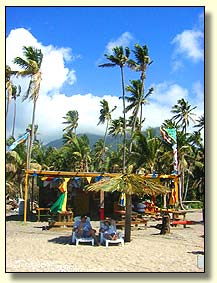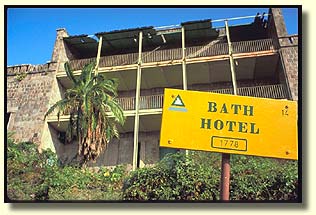
St. Kitts & Nevis
Original Official Site of the
St. Kitts & Nevis
Department of Tourism
Exploring St. Kitts | Exploring
Nevis
Exploring Nevis:
 Pinney's
Beach Pinney's
Beach
One of the Caribbean's best beaches, Pinney's is not to be missed
during a stay on the island. Its reef-protected waters are great
for both swimming and sunbathing; nearby is the palm-fringed
lagoon of Nelson's Spring.
Cotton Ground
This diminutive village is situated close by to Nelson's Spring,
the picturesque fresh water source from which Horatio Nelson
is said to have replenished his ship's supply of drinking water
during his tour in the Leeward Islands.
Fort Ashby
The rise on which Fort Ashby is located is said to look out
over the spot on which Jamestown, Nevis' first capital, once
stood. According to legend, the town is supposed to have slid
into the sea when an earthquake and subsequent tidal wave hit
in 1680. Despite claims that ruins can be seen under the sea
when the sand shifts, and rumors that during the full moon Jamestown's
church bells can be heard tolling from under the waves, it seems
that the town was in fact damaged (and not sunk) during the well-documented
earthquake of 1690, only to be slowly abandoned over the following
decades.
Round Hill
From the top of this fine prospect you can see both St. Kitts
and Booby Island--named after the brown pelican or booby, the
Kittitian/Nevisian national bird.
Fig Tree Village
The nominal reason to visit this charming village is to take
a look at the register in St. John's church, in which are the
birth of Alexander Hamilton (in 1757) and the wedding of Horatio
Nelson and Frances (Fanny) Nesbitt in 1787. An equally compelling
reason to make a stop is simply to enjoy the ambience of this
lovely spot.
Montpelier House
Little survives of this once prosperous estate, the site of
Lord Nelson's marriage to Fanny Nisbet. Only the crumbling gate
and a few romantic columns remain of the old manor house.
Eden Brown Estate
This haunting gray ruin was built by
a wealthy Nevisian planter as a wedding gift for his daughter.
However, on the eve of the
wedding, in a drunken duel, the daughter's fiancÚ and the best
man killed each other. In addition to the evocative power of
the ruins themselves, the estate is said to be home to the ghost
of the ill-fated bride-to-be.
Bath
House and Spring House

The ruins here are all that remain of the 18th-century Bath
Hotel, the first resort destination in the Caribbean. Built by
John Huggins in 1778 for the astounding expense of 40,000 island
pounds, this once luxurious hotel attracted many prominent Europeans
to Nevis and its soothing waters. Samuel Taylor Coleridge spent
a number of months here, and it seems undoubted that both Nelson
and his friend Prince William Henry, Duke of Clarence and the
future King William IV, attended gala social functions here in
the 1780s. The hotel's days of splendour ended along with the
collapse of the sugar industry in the 19th century, and the original
structure suffered considerable damage in a 1950 earthquake.
Visitors can still take a mineral bath in the five spas built
on a fault over a hot spring.
Cottle Church
Built in 1824 by Thomas Cottle, President of Nevis and owner
of the Round Hill estate in 1824, so that his family and slaves
could pray together. Unfortunately, the church was never regularly
used, as such integrated worship was explicitly disallowed by
the church during this time. It fell into disrepair, and an earthquake
in 1974 reduced the remaining structure to ruin.
Exploring St. Kitts | Exploring
Nevis
Click here to
see what visitors are saying about interesting places in St.
Kitts & Nevis.
|



